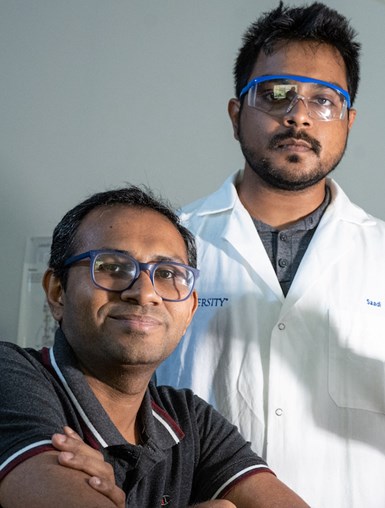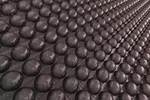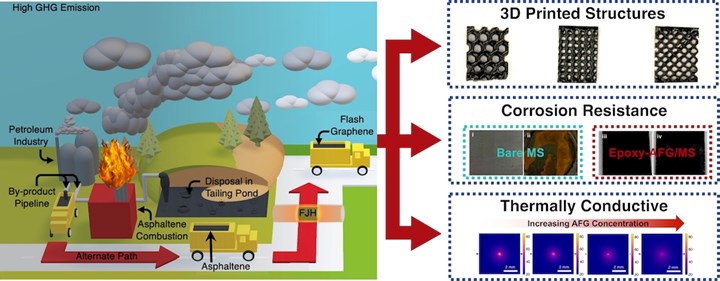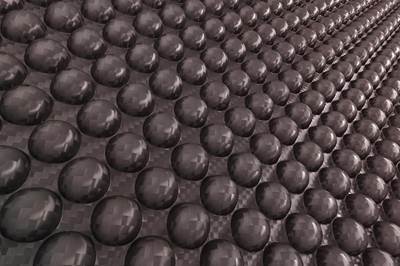Rice University turns asphaltene into graphene for composites
University scientists use novel flash Joule heating process to convert crude oil byproduct into graphene, to then be mixed with composites for thermal, anti-corrosion and 3D-printing applications.
Researchers at Rice are pursuing the “sustainable valorization” of asphaltene by turning it into graphene useful for composite materials. Illustration by M.A.S.R. Saadi
Asphaltenes, a byproduct of crude oil production, are a waste material with potential, according to Rice University (Houston, Texas, U.S.) scientists. Muhammad Rahman, an assistant research professor of materials science and nanoengineering, is employing Rice’s novel flash Joule heating process to convert asphaltenes instantly into turbostratic (loosely aligned) graphene and mix it into composites for thermal, anti-corrosion and 3D-printing applications.
The process is said to make good use of material otherwise burned for reuse as fuel, or discarded into tailing ponds and landfills. Using at least some of the world’s reserve of more than one trillion barrels of asphaltene as a feedstock for graphene would be beneficial for the environment as well.
“Asphaltene is a big headache for the oil industry, and I think there will be a lot of interest in this,” says Rahman, who characterized the process as a scalable and sustainable way to reduce carbon emissions from burning asphaltene.
Rahman is a lead corresponding author of the paper in Science Advances co-led by Rice chemist James Tour, whose lab developed flash Joule heating, materials scientist Pulickel Ajayan and Md Golam Kibria, an assistant professor of chemical and petroleum engineering at the University of Calgary, Canada.
Asphaltenes are 70-80% carbon already, according to Rahman. The Rice lab combines it with about 20% carbon black to add conductivity and flashes it with a jolt of electricity, turning it into graphene in less than a second. Other elements in the feedstock, including hydrogen, nitrogen, oxygen and sulfur, are vented away as gases.
“We try to keep the carbon black content as low as possible because we want to maximize the utilization of asphaltene,” Rahman explains.
“The government has been putting pressure on the petroleum industries to take care of this,” Rice graduate student and co-lead author M.A.S.R. Saadi adds. “There are billions of barrels of asphaltene available, so we began working on this project primarily to see if we could make carbon fiber. That led us to think maybe we should try making graphene with flash Joule heating.”
Assured that Tour’s process worked as well on asphaltene as it did on various other feedstocks, including plastic, electronic waste, tires, coal fly ash and even car parts, the researchers set about making things with their graphene.

Muhammad Rahman (left) and M.A.S.R. Saadi (right). Photo Credit: Jeff Fitlow
Saadi, who works with Rahman and Ajayan, mixed the graphene into composites, and then into polymer inks bound for 3D printers. “We’ve optimized the ink rheology to show that it is printable,” he says, noting the inks have no more than 10% graphene mixed in. Mechanical testing of printed objects is forthcoming.
Rice graduate student Paul Advincula, a member of the Tour lab, is co-lead author of the paper. Co-authors are Rice graduate students Md Shajedul Hoque Thakur, Ali Khater, Jacob Beckham and Minghe Lou, undergraduate Aasha Zinke and postdoctoral researcher Soumyabrata Roy; research fellow Shabab Saad, alumnus Ali Shayesteh Zeraati, graduate student Shariful Kibria Nabil and postdoctoral associate Md Abdullah Al Bari of the University of Calgary; graduate student Sravani Bheemasetti and Venkataramana Gadhamshetty, an associate professor, at the South Dakota School of Mines and Technology (Rapid City) and its 2D Materials of Biofilm Engineering Science and Technology Center; and research assistant Yiwen Zheng and Aniruddh Vashisth, an assistant professor of mechanical engineering, of the University of Washington (Seattle).
The research was funded by the Alberta Innovates for Carbon Fiber Grand Challenge programs, the Air Force Office of Scientific Research (FA9550-19-1-0296), the U.S. Army Corps of Engineers (W912HZ-21-2-0050) and the National Science Foundation (1849206, 1920954).
Related Content
TPI manufactures all-composite Kenworth SuperTruck 2 cab
Class 8 diesel truck, now with a 20% lighter cab, achieves 136% freight efficiency improvement.
Read MoreRocket Lab begins installation of large AFP machine for rocket production
The 99-ton AFP machine, custom-designed and built by Electroimpact, is claimed to be the largest of its kind, expecting to save around 150,000 manufacturing hours in the Neutron rocket’s production process.
Read MoreSinonus launches energy-storing carbon fiber
Swedish deep-tech startup Sinonus is launching an energy-storing composite material to produce efficient structural batteries, IoT devices, drones, computers, larger vehicles and airplanes.
Read MoreCIRA qualifies CMC structures for the reusable Space Rider
Italian team designs, builds and tests multiple large, complex thermal protection system structures made from patented ISiComp C/C-SiC ceramic matrix composites.
Read MoreRead Next
UCalgary researchers turn Alberta oilsands bitumen into high-value carbon fibers
University spearheads three projects out of the 12 teams chosen for Phase II of the Carbon Fibre Challenge, with a new target to produce the carbon fibers from bitumen at a lab scale.
Read MoreCutting 100 pounds, certification time for the X-59 nose cone
Swift Engineering used HyperX software to remove 100 pounds from 38-foot graphite/epoxy cored nose cone for X-59 supersonic aircraft.
Read MoreScaling up, optimizing the flax fiber composite camper
Greenlander’s Sherpa RV cab, which is largely constructed from flax fiber/bio-epoxy sandwich panels, nears commercial production readiness and next-generation scale-up.
Read More


























